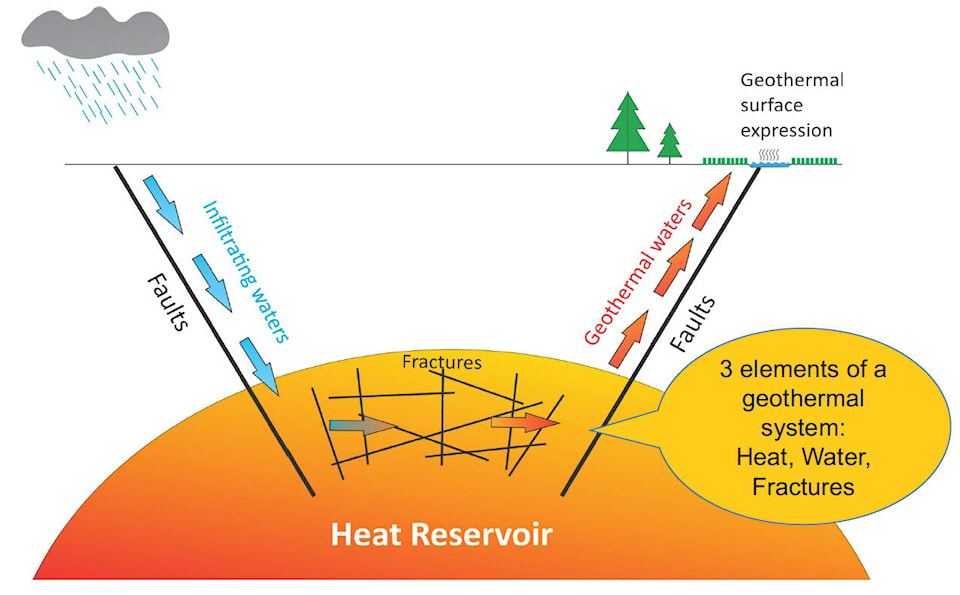A company that wants to drill down hundreds of metres at Lakelse Lake in search of super-heated water — the heat of which could be used for a number of domestic and commercial purposes — faced a mostly skeptical open-house audience in Terrace March 16.
Kitselas Geothermal, a company owned by the Kitselas First Nation’s Kitselas Development Corporation and Calgary-based Borealis GeoPower, must first receive approval from the B.C. Energy Regulator, a provincial agency.
It also has to reach access agreements with the owners of properties on which it wants to drill and it was those property owners who poured out questions and comments for more than two hours in the banquet room of the Days Inn.
There were concerns about the effects on the domestic water table used by property owners surrounding Mount Layton Hotsprings, which would be the centre of the proposed drilling; the noise and disruption caused by drilling; and what would happen if a commercial geothermal development was possible.
Borealis Geo-Power’s Tim Thompson told the audience the M’Deek underground super-heated water reservoir is far below the water source residents now rely on.
Piping to bring the water to the surface means there won’t be any intermingling, he added.
“What happens if we spill, nothing. It’s water. The impact of a spill doesn’t persist,” he said.
Thompson said a looping system would ensure that every litre of water brought to the surface would then be returned to the reservoir where it would be heated again thanks to the heat present below the surface.
Existing fractures in bedrock ensure there was no chance that drilling through that same bedrock would release the kind of pressures that cause earthquakes, he added.
Residents challenged Thompson on the disruption to their property and lifestyle should the M’Deek reservoir prove to be commercially viable.
“There’s been hundreds of millions of dollars of personal investment …. of value tied up in our homes,” said one.
Thompson said that once drilling is finished and wells are in place, the area will be returned so that no one will know Kitselas Geothermal has ever been there.
“You are surface rights holders and I’m a sub-surface rights holder,” he added.
“I have a right in a strict and legal sense,” Thompson continued but did say he needs agreements with property holders if they are to be affected by traffic, shift changes and drill platform construction.
Another Lakelse Lake resident, Ken Belanger, told Thompson his company was only in the area to make money.
“Let’s recognize that no corporation works for a loss,” Thompson replied.
Residents were also generally unsatisfied with how many holes Kitselas wants to drill this year.
Based on the permit application, the plan is to drill up to 10 shallow wells of 200 to 400 metres to get a sense of water heat and bedrock properties and up to four wells of up to 2,000 metres to test the rock formations and water underneath Mount Layton Hotsprings.
Thompson said it was impossible to provide an exact number as the number of eventual drill holes will depend upon what the first three or four holes tell the company.
Thompson also stressed that Kitselas Geothermal won’t be in the business of deciding how the heat from its water will be used.
“Our water will heat their water and we go away,” he said of customers that would build their own facilities to transfer the heat from the Kitselas water for their own purposes.
Thompson did say that other geothermal projects produce heat for buildings and hot water for domestic and other use.
He called geothermal an emissions-free source of long-lasting power that is price competitive with other power sources.
Kitselas First Nation chief councillor Glenn Bennett provided opening and closing remarks at the open house, saying the goal of the session was to hear from the public.
He added that the project has great economic and other potential benefits for all residents of the area as forestry becomes less of a presence.
“We’ve seen the sawmills go down, go under, but we’re still here,” he said.
Kitselas Geothermal has been exploring around the Lakelse Lake area since 2011 when Enbridge made an investment in the project. Enbridge has since bowed out and Shell bought into Kitselas Geothermal last year.
Several years ago, Skeena Bioenergy expressed an interest in Kitselas Geothermal’s water, suggesting a pipeline from its wells to its pellet plant could replace natural gas as a source for drying chips before being compressed into pellets.
“Renewable, geothermal heat is available 24/7. There are customers that closely match that profile in the Terrace area and we anticipate there will be others in the future who locate at the industrial park,” Kitselas Geothermal indicated in a statement following the open house in referring to the Skeena Industrial Development Park south of the airport.
Thompson said $6 million has been spent to date, a figure that includes a $500,000 grant from the provincial government last year.
Previously-released information indicates there was drilling on the west side of Lakelse Lake, across the water from Mount Layton Hotsprings and that licences had been obtained for drilling within an area of approximately 2,800 hectares on traditional Kitselas territory extending from south of Lakelse Lake and up the east side.
Follow up information from Kitselas Geothermal indicated the west side drilling “informed our reservoir model” but provided no detail as to the commercial viability of a project.



